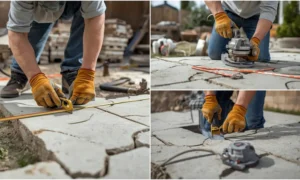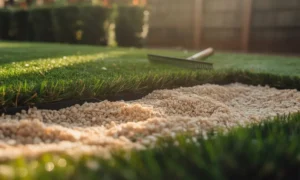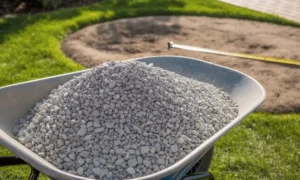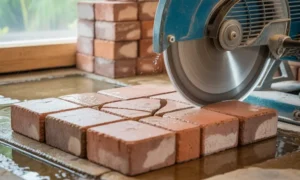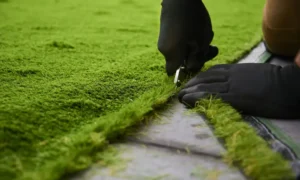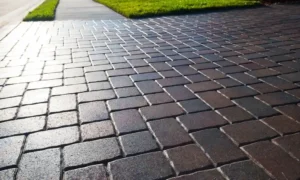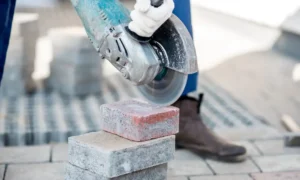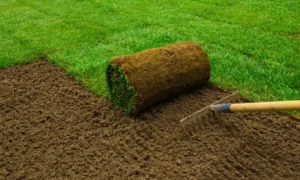When it comes to landscaping, one of the most important steps is making sure you calculate landscape rock accurately. Whether you’re designing a flower bed, creating a pathway, or refreshing your entire yard, getting the right amount of rock can make all the difference. Too little, and you’ll end up with patchy results or multiple trips to the store. Too much, and you’ve spent money on materials you don’t need.
From decorative flower beds to durable walkways and low-maintenance ground cover, stone is a versatile and popular choice in many outdoor projects. But before you load up your cart or place a bulk order, calculating stone for landscaping is key to saving both time and money. With a few simple measurements and the right approach, you can avoid waste, stay on budget, and make your landscaping project a success.
How Is Stone Coverage Calculated for Landscaping?
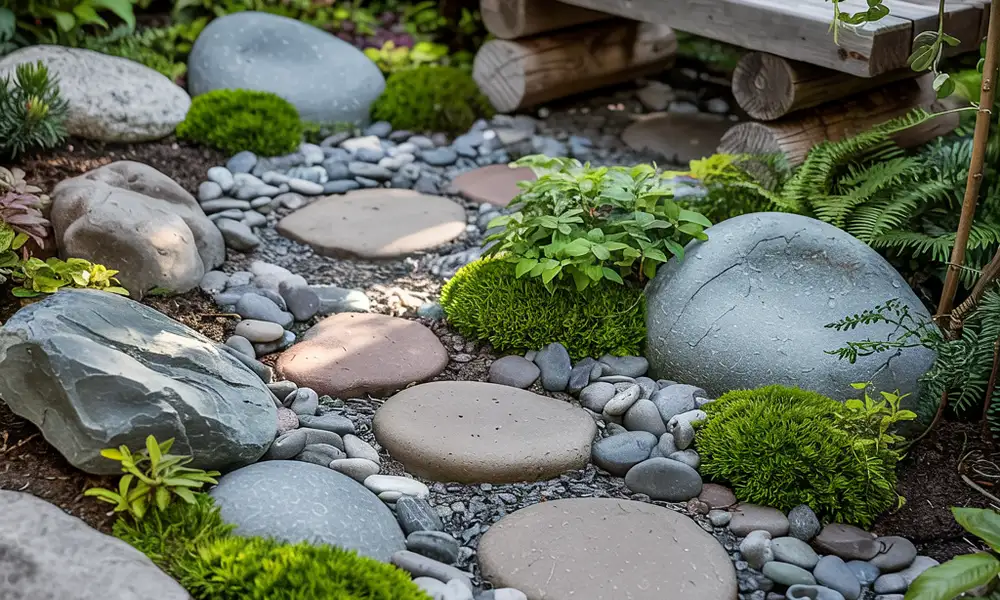
When planning a landscaping project, figuring out how much stone you need is essential to avoid over- or under-buying. Whether you’re using gravel, river rock, or crushed stone, the amount required depends on your area size and the desired depth. That’s where a rock landscaping calculator comes in handy. Let’s break it down.
Common Units Used
Before diving into the formula, it’s important to understand these common measurement units:
- Cubic Feet (ft³): Volume measured in feet.
- Cubic Yards (yd³): 1 cubic yard = 27 cubic feet.
- Tons: A common weight unit used when placing supplier orders for rock.
Stone Coverage Formula
To determine the number of cubic yards of stone required:
Length (ft)×Width (ft)×Depth (in) = cubic yards\frac = 324\text{Cubic yards}{\text{Depth (in)}}{324} \times \text{Width (ft)} \times \text{Length (ft)}324 cubic yardsDepth (in) × Length (ft) × Width (ft)
Why 324? Since one yard is equivalent to three feet, 3 feet × 3 feet × (1 foot = 12 inches) equals 324 inches³ in a cubic yard.
Conversion Tips
- One inch is equivalent to 0.0833 feet.
- Cubic Yards to Tons: Multiply cubic yards by the weight of the rock per yard, which varies based on the type of rock and is typically between 1.2 and 1.7 tons/yd³.
If you’re asking, “how many tons of rock do I need?”, you’ll first need to calculate the volume in cubic yards and then convert that to tons.
Example:
Area: 10 ft x 10 ft
Depth: 2 inches
Cubic yards = 10×10×2324 = 200324≈0.62 cubic yards\text{Cubic yards} = \frac{10 \times 10 \times 2}{324} = \frac{200}{324} \approx 0.62 \text{ cubic yards}32410×10×2 = 324200 cubic yards, or almost 0.62 cubic yards
Now, convert to tons. Taking into account an average of 1.4 tons per cubic yard:
0.62×1.4≈0.87 tons0.62 \times 1.4 \approx 0.87 \text{ tons}0.62×1.4≈0.87 tons
So for a 10×10 ft area at 2 inches deep, you would need approximately 0.87 tons of rock.
How Many Tons of Rock Do I Need Per Square Foot?
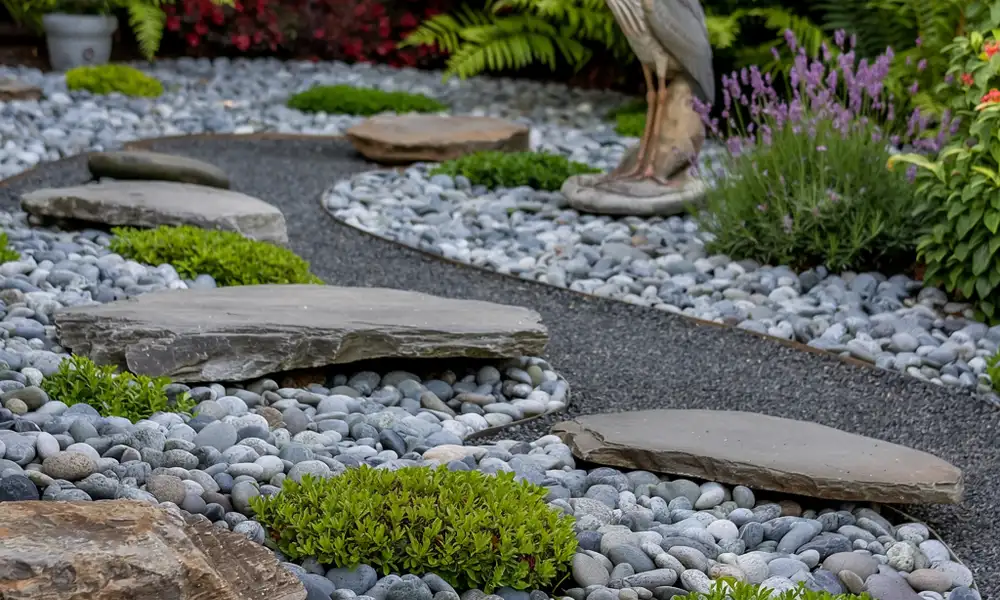
When you’re calculating stone for landscaping, a quick and simple method is to estimate how many tons of rock per square foot you’ll need based on the depth of coverage. This approach works great when you’re in a hurry or working on-site without a calculator.
Quick Reference Guide: Tons per Square Foot by Depth
Depth (inches) | Tons per Square Foot |
1 inch | 0.008 tons/sq ft |
2 inches | 0.017 tons/sq ft |
3 inches | 0.025 tons/sq ft |
How to Use This Chart for Fast Estimates
To calculate landscape rock needs quickly:
- Determine the area in square feet (length × width).
- Choose your desired depth in inches.
- Multiply the area by the tons/sq ft value from the chart.
Example:
Suppose you wish to cover a 500 square foot area with two inches of ornamental stone:
500 sq ft×0.017 tons/sq ft=8.5 tons500 \text{ sq ft} \times 0.017 \text{ tons/sq ft} = 8.5 \text{ tons}500 sq ft×0.017 tons/sq ft=8.5 tons
Therefore, about 8.5 tons of rock would be required.
Consider the Stone Type and Density
Not all rocks weigh the same. For instance:
- Granite or river rock is heavier than lava rock or decomposed granite.
- For large projects in particular, always ask your supplier what the material’s specific weight is per cubic yard or ton.
Even with this general chart, calculating stone for landscaping can vary based on rock type and moisture content. For the most accurate estimate, combine this method with a rock landscaping calculator.
You can also read about Bay Area Landscape construction.
What Is The Required Amount Of Rock For Flower Beds?
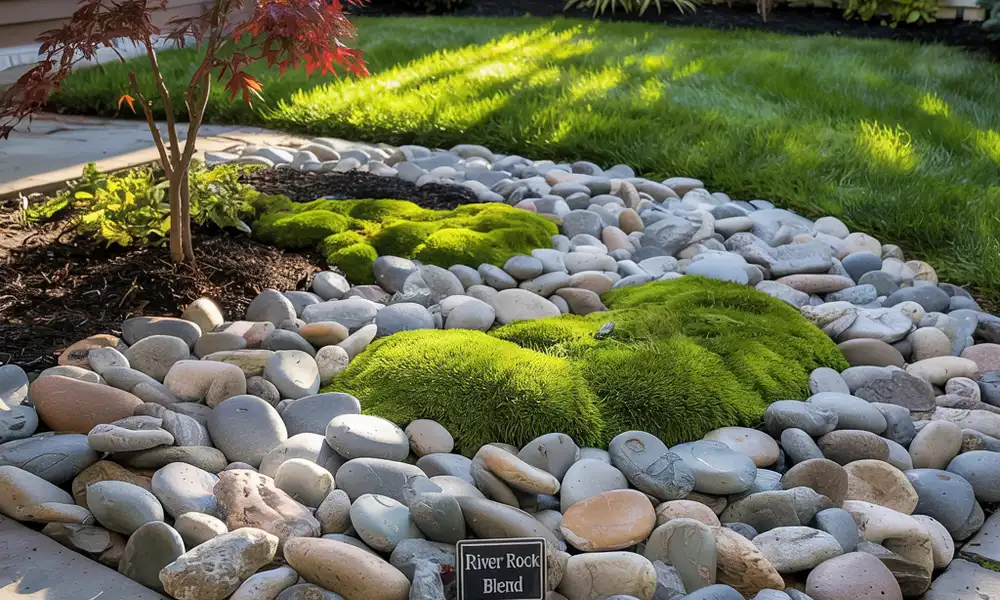
Using decorative rock in flower beds is not only stylish but also low-maintenance. To figure out how much you need, it’s important to consider coverage depth, the size of the area, and how you plan to keep everything neat and contained. A rock landscaping calculator can make the process quick and easy, but here’s how to calculate it manually as well.
Ideal Depth for Flower Beds
A rock depth of 1.5 to 2 inches is optimal for the majority of flower bed applications:
- 1.5 inches for lighter coverage or smaller rock.
- For complete coverage and improved weed suppression, use 2 inches..
This depth gives you a clean look without suffocating nearby plants.
Don’t Skip the Weed Barrier
Before you lay the rock, install a landscape fabric or weed barrier underneath. This helps:
- Prevent weeds from pushing through the rock.
- Make future cleanup or rock replacement easier.
- Prevent the rocks from gradually settling into the ground.
Edging Tips to Keep Rocks in Place
To maintain clean lines and stop rocks from spilling into your lawn or walkways:
- Use metal, plastic, or stone edging around the perimeter.
- Make sure the edging is at least 2 inches high to contain the rock.
- Bury part of the edging to keep it stable and reduce shifting.
Example: Calculate Landscape Rock for a Small Garden Bed
Let’s say your flower bed is eight feet long and three feet wide. You want two inches of attractive rock.
- It is eight by three by twenty-four square feet.
- Convert to cubic yards using the formula:
“Cubic Yards” = “Length (ft)×Width (ft)×Depth (in)324{\text{Depth (in)}} \times \text{Width (ft)} \times \text{Length (ft)}{324}A cubic yard is equal to 324 length (ft) × width (ft) × depth (in) = 8×3×2324 = 48324≈0.15 cubic yards = \frac{8 × 3 × 2}{324} = \frac{48}{324} ≈ 0.15 \text{ cubic yards}=3248×3×2=32448≈0.15 cubic yards
- Convert to tons (assuming 1.4 tons per cubic yard):
0.15×1.4=0.21 tons0.15 × 1.4 = 0.21 \text{ tons}0.15×1.4=0.21 tons
So, you’d need about 0.21 tons of rock for this small garden bed.
Use a Rock Landscaping Calculator
If math isn’t your thing or you have multiple beds to cover, a rock landscaping calculator is your best friend. It quickly helps you calculate landscape rock amounts by entering your dimensions and desired depth.
You can also read about 11 Stunning Side Yard Landscaping Ideas.
How Much Rock Do I Need for Pathways?
Rock pathways are a great low-maintenance landscaping option, but getting the amount right is key to durability and appearance. Whether you’re going for a casual garden trail or a heavy-use walkway, here’s how to plan and calculate the rock you’ll need.
Recommended Rock Depth for Pathways
- 2 inches: Best for light foot traffic—like garden paths or decorative walkways.
- 3 inches: Ideal for frequent use or areas with moderate foot traffic
- 4 inches or more: Needed for heavier-duty use—like wheelbarrow paths, carts, or bike use.
Deeper coverage adds stability, especially when paired with a strong base layer.
Why a Compacted Base Layer Matters
Before adding decorative rock or gravel, a compacted base is essential. This prevents the path from shifting, settling, or becoming uneven over time.
- Use: Crushed stone (like Class 5 or crushed limestone)
- Depth: Typically 2–4 inches, compacted in layers
- Benefits:
- Better drainage
- Firmer walking surface
- Improved longevity of your path
Best Rock Types for Pathways
Not all landscape rocks are great for walking on. Here’s a breakdown of popular choices:
Rock Type | Pros | Cons |
Crushed Gravel | Angular stones lock together well; stable surface | Can be dusty; may require compacting |
Decomposed Granite | Packs tightly; smooth and firm | Needs occasional maintenance |
Pea Gravel | Smooth and comfortable underfoot | Can shift easily; needs solid edging |
River Rock | Attractive and natural look | Too smooth—can roll underfoot, unstable |
Sample Calculation: Heavier-Duty Path
Let’s say you’re building a 4-foot-wide, 25-foot-long path, with 3 inches of crushed gravel.
Area = 4 ft × 25 ft = 100 sq ft
Depth = 3 inches
Convert to cubic yards using the formula:
Cubic Yards=Length×Width×Depth324=100×3324≈0.93 cubic yards\text{Cubic Yards} = \frac{Length \times Width \times Depth}{324} = \frac{100 \times 3}{324} ≈ 0.93 \text{ cubic yards}Cubic Yards=324Length×Width×Depth=324100×3≈0.93 cubic yards
Convert to tons (assuming 1.4 tons per cubic yard):
0.93×1.4≈1.3 tons0.93 \times 1.4 ≈ 1.3 \text{ tons}0.93×1.4≈1.3 tons
For this pathway, you’ll need approximately 0.93 cubic yards or 1.3 tons of rock.
Final Thoughts
Wondering how much rock you need for your landscaping project? Whether it’s for pathways, flower beds, or decorative features, getting the right amount is crucial for a clean, lasting finish. Use proper depth guidelines and measurements to plan your materials accurately. A rock landscaping calculator can help, but if you’d rather leave the math to the pros—we’ve got you covered. At Lakota Design Group, we specialize in landscape design and installation, including rock and stone work. From planning to execution, we handle it all.
Call us at (408) 826-2888 to get started today!
FAQs
How Do I Calculate How Much Rock I Need For My Project?
To calculate how much rock you need, you should determine the area (in square feet or square yards) where you plan to place the rock and the desired depth. Then, multiply the area by the depth (in feet). Most rock is sold by the cubic yard, so divide your total volume by 27 (since there are 27 cubic feet in a cubic yard) to get the amount you need in cubic yards.
How Many Cubic Yards Of Rock Do I Need For A 10×10 Foot Area At 2 Inches Deep?
To calculate the volume of rock needed, first convert the inches to feet (2 inches = 0.167 feet). Then, multiply the area (10 feet x 10 feet = 100 square feet) by the depth (0.167 feet). So, 100 x 0.167 = 16.7 cubic feet. Divide that by 27 to convert to cubic yards: 16.7 ÷ 27 = 0.62 cubic yards.
How Do I Convert Tons Of Rock To Cubic Yards?
The conversion between tons and cubic yards depends on the type of rock, as different types have different densities. On average, 1 cubic yard of rock weighs around 1.5 tons, but it’s best to check with your supplier for the specific weight of the rock you’re purchasing.
How Deep Should I Lay The Rock For My Driveway Or Walkway?
For a driveway, you should aim for a depth of 4 to 6 inches of rock for adequate support. For a walkway, 2 to 3 inches is typically sufficient. Adjust the depth based on your project needs and the size of the rock.
What Is The Best Type Of Rock For Landscaping Or A Driveway?
For landscaping, smaller decorative rocks like pea gravel or river rock are often used. For driveways, larger rocks such as crushed stone or gravel are recommended due to their durability and ability to handle vehicle traffic.




